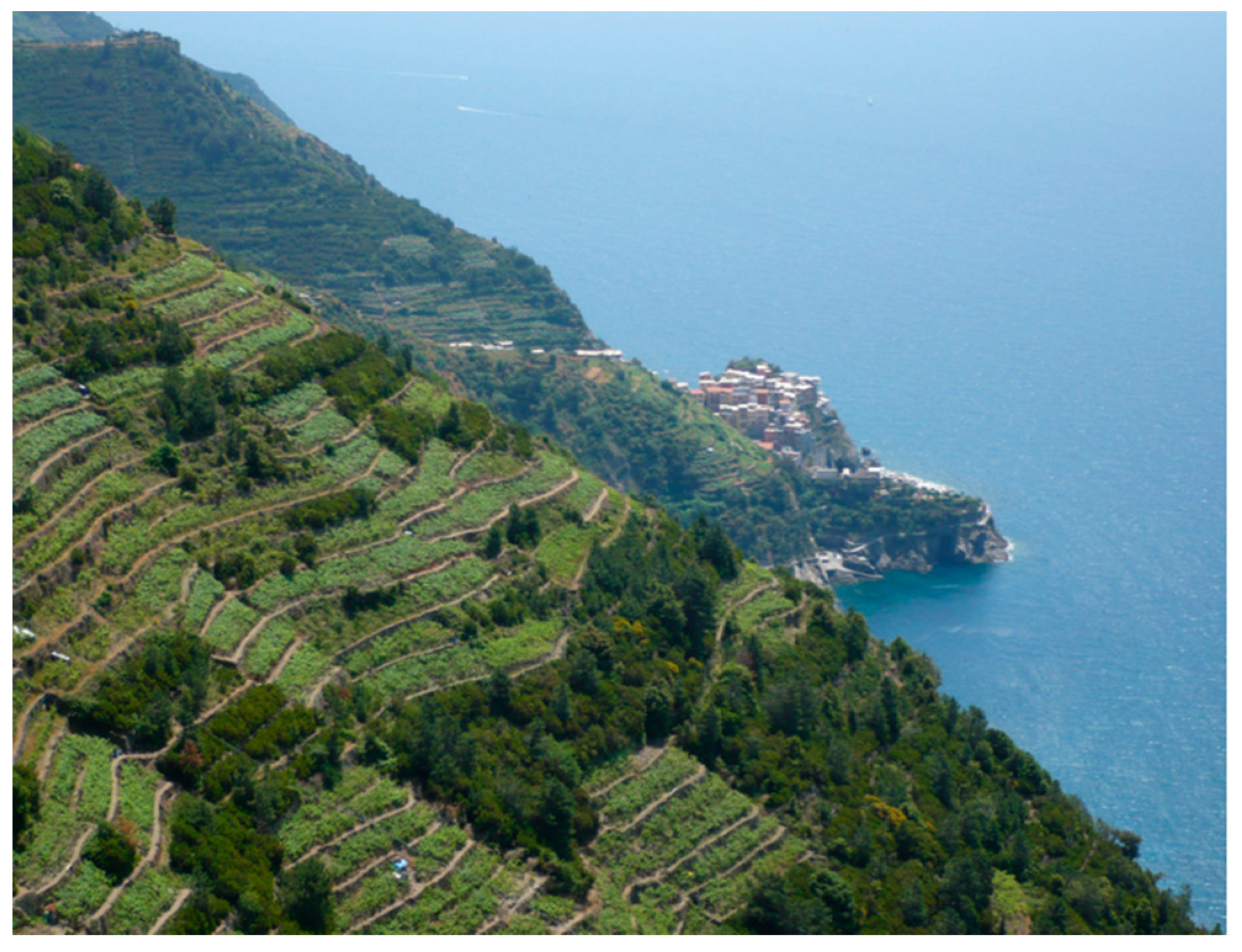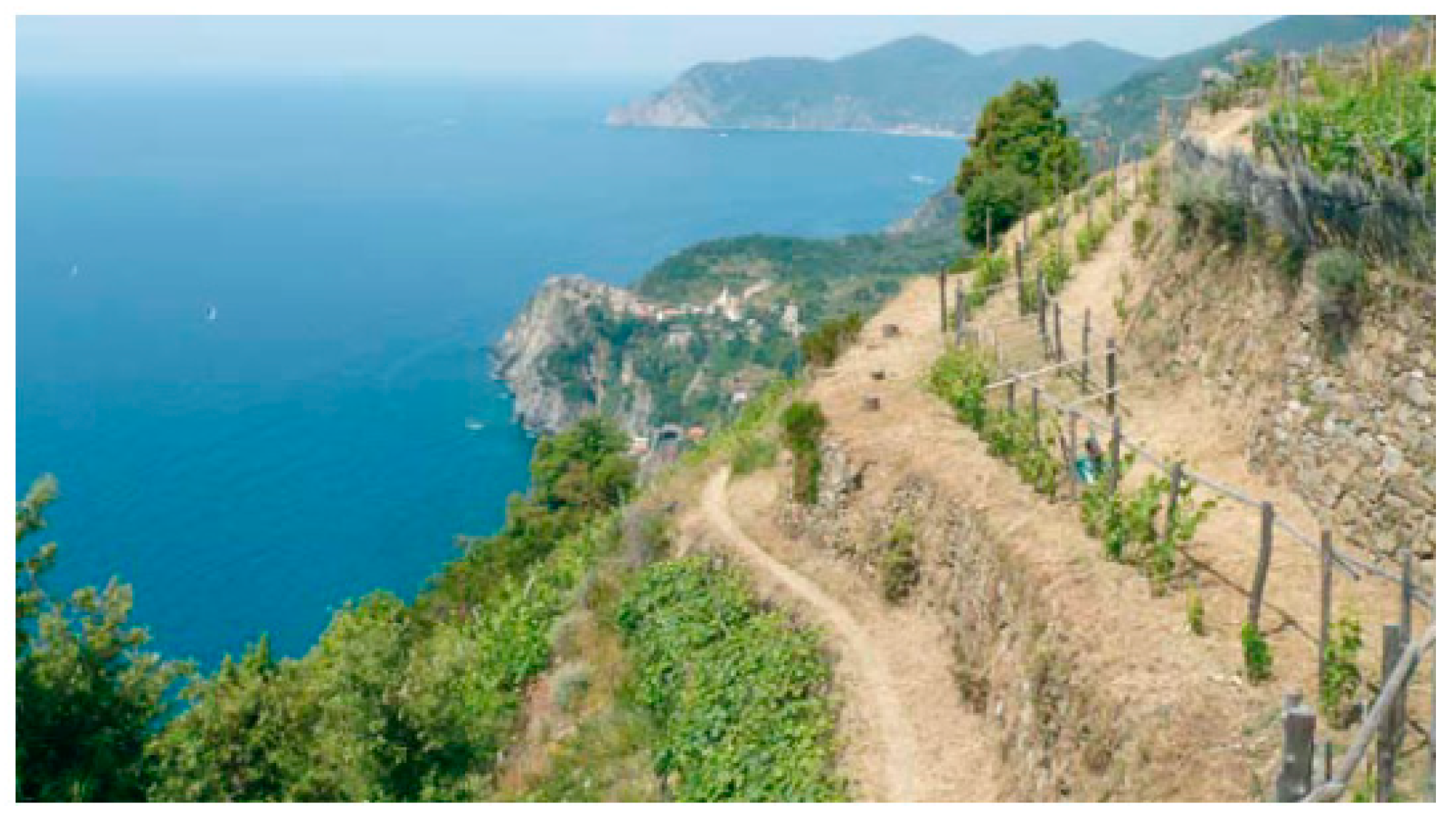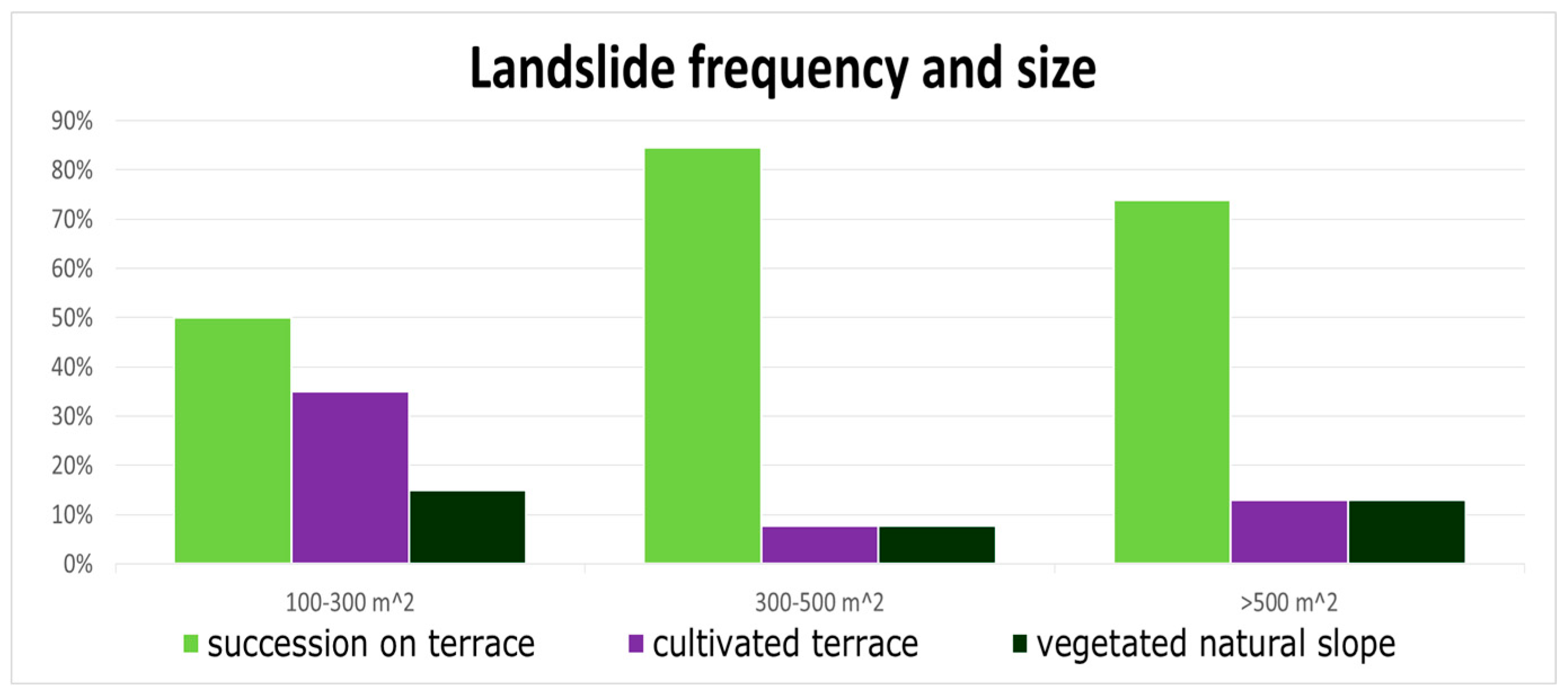Terraced Landscapes and Hydrogeological Risk. Effects of Land Abandonment in Cinque Terre (Italy) during Severe Rainfall Events
Abstract
:1. Introduction
History of Cinque Terre and Its Viticulture
2. Materials and Methods
The Cinque Terre and the 25 October 2011 Rainstorm
3. Results
4. Discussion
5. Conclusions
Author Contributions
Funding
Conflicts of Interest
References
- Walther, P. Land abandonment in Swiss Alps: A new understanding of a land-use problem. Mt. Res. 1986, 6, 305–314. [Google Scholar] [CrossRef]
- Garcia-Ruiz, J.M.; Lasanta-Martinez, T. Land-use changes in the Spanish Pyrenees. Mt. Res. Dev. 1990, 10, 267–279. [Google Scholar] [CrossRef]
- Harden, C.P. Interrelationships between land abandonment and land degradation: A case from the Ecuadorian Andes. Mt. Res. Dev. 1996, 16, 274–280. [Google Scholar] [CrossRef]
- Kamada, M.; Nakagoshi, N. Influence of cultural factors on landscapes of mountainous farm villages in western Japan. Landsc. Urban Plan. 1997, 37, 83–90. [Google Scholar] [CrossRef]
- MacDonald, D.; Crabtree, J.R.; Wlesinger, G.; Dax, T.; Stamou, N.; Fleury, P.; Lazplta, J.G.; Gibon, A. Agricultural abandonment in mountain areas of Europe: Environmental consequences and policy response. J. Environ. Manag. 2000, 59, 47–69. [Google Scholar] [CrossRef] [Green Version]
- Romero-Clacerrada, R.; Perry, G.L.W. The role of land abandonment in landscape dynamics in the SPA “Encinares del Rio Alberche y Cofio, Central Spain”. Landsc. Urban Plan. 2004, 66, 217–232. [Google Scholar]
- Wei, W.; Chen, D.; Wang, L.; Daryanto, S.; Chen, L.; Yu, Y.; Lu, Y.; Sun, G.; Feng, T. Global synthesis of the classifications, distributions, benefits and issues of terracing. Earth-Sci. Rev. 2016, 159, 388–403. [Google Scholar] [CrossRef] [Green Version]
- Stanchi, S.; Freppaz, M.; Agnelli, A.; Reinsch, T.; Zanini, E. Properties, best management practices and conservation of terraced soils in Southern Europe (from Mediterranean areas to the Alps): A review. Quat. Int. 2012, 265, 90–100. [Google Scholar] [CrossRef] [Green Version]
- Llorens, P.; Latron, J.; Gallart, F. Analysis of the role of agricultural abandoned terraces on the hydrology and sediment dynamics in a small mountainous basin (High Llobregat, Eastern Pyrenees). Pirineos 1992, 139, 27–46. [Google Scholar] [CrossRef]
- Gallart, F.; Llorens, P.; Latron, J. Studying the role of old agricultural terraces on runoff generation in a Mediterranean small mountainous basin. J. Hydrol. 1994, 159, 291–303. [Google Scholar] [CrossRef]
- Camera, C.A.; Apuani, T.; Masetti, M. Mechanisms of failure on terraced slopes: The Valtellina case (northern Italy). Landslides 2012, 11, 43–54. [Google Scholar] [CrossRef]
- Tarolli, P.; Preti, F.; Romano, N. Terraced landscapes: From an old best practice to a potential hazard for soil degradation due to land abandonment. Anthropocene 2014, 6, 10–25. [Google Scholar] [CrossRef]
- Arnaèz, J.; Lana-Renault, N.; Lasanta, T.; Ruiz Flaño, P.; Castroviejo, J. Effects of farming terraces on hydrological and geomorphological processes. A review. Catena 2015, 128, 122–134. [Google Scholar] [CrossRef] [Green Version]
- Agnoletti, M.; Conti, L.; Frezza, L.; Santoro, A. Territorial Analysis of the Agricultural Terraced Landscapes of Tuscany (Italy): Preliminary Results. Sustainability 2015, 7, 4564–4581. [Google Scholar] [CrossRef] [Green Version]
- Bellin, N.; van Wesemael, B.; Meerkerk, A.; Vanacker, V.; Barbera, G.G. Abandonment of soil and water conservation structures in Mediterranean ecosystems. A case study from south east Spain. Catena 2009, 76, 114–121. [Google Scholar] [CrossRef]
- Romero Díaz, A.; Marín Sanleandro, P.; Sánchez Soriano, A.; Belmonte Serrato, F.; Faulkner, H. The causes of piping in a set of abandoned agricultural terraces in southeast Spain. Catena 2007, 69, 282–293. [Google Scholar] [CrossRef]
- Shrestha, D.P.; Zinck, J.A.; Van Rast, E. Modelling land degradation in the Nepalese Himalaya. Catena 2004, 57, 135–156. [Google Scholar] [CrossRef]
- Agnoletti, M. The degradation of traditional landscape in a mountain area of Tuscany during the 19th and 20th centuries: Implications for biodiversity and sustainable management. For. Ecol. Manag. 2007, 249, 5–17. [Google Scholar] [CrossRef]
- López-Vicente, M.; Poesen, J.; Navas, A.; Gaspar, L. Predicting runoff and sediment connectivity and soil erosion by water for different land use scenarios in the Spanish Pre-Pyrenees. Catena 2013, 102, 62–73. [Google Scholar] [CrossRef] [Green Version]
- Savo, V.; Caneva, G.; McClatchey, W.; Reedy, D.; Salvati, L. Combining environmental factors and agriculturalists’ observations of environmental changes in the traditional terrace system of the Amalfi coast (Southern Italy). Ambio 2014, 43, 297–310. [Google Scholar] [CrossRef]
- Caneva, G.; Galotta, G.; Cancellieri, L.; Savo, V. Tree roots and damages in the Jewish catacombs of Villa Torlonia (Roma). J. Cult. Herit. 2009, 10, 53–62. [Google Scholar] [CrossRef]
- Schwarz, M.; Preti, F.; Giadrossich, F.; Lehmann, P.; Or, D. Quantifying the role of vegetation in slope stability: A case study in Tuscany (Italy). Ecol. Eng. 2010, 36, 285–291. [Google Scholar] [CrossRef]
- Giadrossich, F.; Schwarz, M.; Cohen, D.; Preti, F.; Or, D. Mechanical interactions between neighbouring roots during pullout tests. Plant Soil 2013, 367, 391–406. [Google Scholar] [CrossRef]
- Preti, F. Forest protection and protection forest: Tree root degradation over hydrological shallow landslides triggering. Ecol. Eng. 2013, 61, 633–645. [Google Scholar] [CrossRef]
- Arnone, E.; Caracciolo, D.; Noto, L.V.; Preti, F.; Bras, R.L. Modeling the hydrological and mechanical effect of roots on shallow landslides. Water Resour. Res. 2016, 52, 8590–8612. [Google Scholar]
- Carl, T.; Richter, M. Geoecological and morphological processes on abandoned vine-terraces in the Cinque Terre (Liguria). Geoòkodynamic 1989, 10, 125–158. [Google Scholar]
- Agnoletti, M.; Cargnello, G.; Gardin, L.; Santoro, A.; Bazzoffi, P.; Sansone, L.; Pezza, L.; Belfiore, N. Traditional landscape and rural development: Comparative study in three terraced areas in northern, central and southern Italy to evaluate the efficacy of GAEC standard 4.4 of cross compliance. Ital. J. Agron. 2011, 6 (Suppl. 1), 121–139. [Google Scholar] [CrossRef]
- Cevasco, A.; Brandolini, P.; Scopesi, C.; Rellini, I. Relationships between geo-hydrological processes induced by heavy rainfall and land-use: The case of 25 October 2011 in the Vernazza catchment (Cinque Terre, NW Italy). J. Maps 2013, 9, 289–298. [Google Scholar]
- Galve, J.P.; Cevasco, A.; Brandolini, P.; Soldati, M. Assessment of shallow landslide risk mitigation measures based on land use planning through probabilistic modelling. Landslides 2015, 12, 101–114. [Google Scholar] [CrossRef]
- D’Amato Avanzi, G.; Galanti, Y.; Giannecchini, R.; Mazzali, A.; Saulle, G. Remarks on the 25 October 2011 rainstorm in Eastern Liguria and Northwestern Tuscany (Italy) and the related landslides. Rend. Online Soc. Geol. Ital. 2013, 24, 76–78. [Google Scholar]
- Agnoletti, M.; Conti, L.; Frezza, L.; Monti, M.; Santoro, A. Features analysis of dry stone walls of Tuscany (Italy). Sustainability 2015, 7, 13887–13903. [Google Scholar] [CrossRef]
- Marmocchi, F.C. Descrizione Dell’Italia; Poligrafica Italiana: Firenze, Italy, 1846. [Google Scholar]
- Brancucci, G.; Ghersi, A.; Ruggiero, M.E. Paesaggi Liguri a Terrazze. Riflessioni per una Metodologia di Studio; Alinea Editrice: Firenze, Italy, 2000. [Google Scholar]
- Ghersi, A.; Ghiglione, G. Paesaggi Terrazzati. I Muretti a Secco Nella Tradizione Rurale Ligure; Il Piviere: Alessandria, Italy, 2012. [Google Scholar]
- Storti, M. Il Paesaggio Storico Delle Cinque Terre. Individuazione di Regole per Azioni di Progetto Condivise; Firenze University Press: Firenze, Italy, 2004. [Google Scholar]
- Abbate, E. Geologia delle Cinque Terre e dell’entroterra di Levanto (Liguria Orientale). Mem. Soc. Geol. Ital. 1969, 8, 923–1014. [Google Scholar]
- Giammarino, S.; Giglia, G. Gli Elementi Strutturali Della Piega di La Spezia Nel Contesto Geodinamico Dell’Appennino Settentrionale. Boll. Soc. Geol. Ital. 1990, 109, 683–692. [Google Scholar]
- Cevasco, A.; Pepe, G.; Brandolini, P. The influences of geological and land use settings on shallow landslides triggered by an intense rainfall event in a coastal terraced environment. Bull. Eng. Geol. Environ. 2014, 73, 859–875. [Google Scholar] [CrossRef]
- Cerdà, A. Soil erosion after land abandonment in a semiarid environment of southeastern Spain. Arid Soil Res. Manag. 1997, 11, 163–176. [Google Scholar] [CrossRef]
- Preti, F.; Errico, A.; Caruso, M.; Dani, A.; Guastini, E. Dry-stone wall terrace monitoring and modelling. Land Degrad. Dev. 2018, 29, 1806–1818. [Google Scholar] [CrossRef]
- Preti, F.; Guastini, E.; Penna, D.; Dani, A.; Cassiani, G.; Boaga, J.; Deiana, R.; Romano, N.; Nasta, P.; Palladino, M.; et al. Conceptualization of water flow pathways in agricultural terraced landscapes. Land Degrad. Dev. 2018, 29, 651–662. [Google Scholar] [CrossRef]
- Tarolli, P.; Sofia, G.; Calligaro, S.; Prosdocimi, M.; Preti, F.; Dalla Fontana, G. Vineyards in Terraced Landscapes: New Opportunities from Lidar Data. Land Degrad. Dev. 2015, 26, 92–102. [Google Scholar] [CrossRef]
- Brandolini, P.; Cevasco, A.; Capolongo, D.; Pepe, G.; Lovergine, F.; Del Monte, M. Response of terraced slopes to a very intense rainfall event and relationships with land abandonment: A case study from Cinque Terre (Italy). Land Degrad. Dev. 2018, 29, 630–642. [Google Scholar] [CrossRef]
- Stokes, A.; Douglas, G.B.; Fourcaud, T.; Giadrossich, F.; Gillies, C.; Hubble, T.; Kim, J.H.; Loades, K.W.; Mao, Z.; McIvor, I.R.; et al. Ecological mitigation of hillslope instability: Ten key issues facing researchers and practitioners. Plant Soil 2014, 377, 1–23. [Google Scholar] [CrossRef]
- Preti, F.; Forzieri, G.; Chirico, G.B. Forest cover influence on regional flood frequency assessment in Mediterranean catchments. Hydrol. Earth Syst. Sci. 2011, 15, 3077. [Google Scholar] [CrossRef]







© 2019 by the authors. Licensee MDPI, Basel, Switzerland. This article is an open access article distributed under the terms and conditions of the Creative Commons Attribution (CC BY) license (http://creativecommons.org/licenses/by/4.0/).
Share and Cite
Agnoletti, M.; Errico, A.; Santoro, A.; Dani, A.; Preti, F. Terraced Landscapes and Hydrogeological Risk. Effects of Land Abandonment in Cinque Terre (Italy) during Severe Rainfall Events. Sustainability 2019, 11, 235. https://doi.org/10.3390/su11010235
Agnoletti M, Errico A, Santoro A, Dani A, Preti F. Terraced Landscapes and Hydrogeological Risk. Effects of Land Abandonment in Cinque Terre (Italy) during Severe Rainfall Events. Sustainability. 2019; 11(1):235. https://doi.org/10.3390/su11010235
Chicago/Turabian StyleAgnoletti, Mauro, Alessandro Errico, Antonio Santoro, Andrea Dani, and Federico Preti. 2019. "Terraced Landscapes and Hydrogeological Risk. Effects of Land Abandonment in Cinque Terre (Italy) during Severe Rainfall Events" Sustainability 11, no. 1: 235. https://doi.org/10.3390/su11010235
APA StyleAgnoletti, M., Errico, A., Santoro, A., Dani, A., & Preti, F. (2019). Terraced Landscapes and Hydrogeological Risk. Effects of Land Abandonment in Cinque Terre (Italy) during Severe Rainfall Events. Sustainability, 11(1), 235. https://doi.org/10.3390/su11010235






